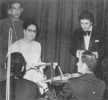The interview with Virginia Danileson, the author of “The Voice of : Umm Kulthum, Arabic Song, and Egyptian Society in the Twentieth Century†(University of Chicago Press. 1997), I have found just became to interesting to do it simply as an extended UPDATE on Umm Kulthum, so I thought to play it out as a prolonged interlude – especially as this text opens up so much of an understanding for her person and the specific approach to voice and singing, and at the same time offers a deep insight into the cultural roots of her performance structures:
| .. What is a widely shared aesthetic in the Arab world is that of singing poetry, in other words using your voice and melody, and then improvisations, melodic improvisations, in order to really bring out the meaning of an important text. And these were important texts. It was fundamental to her career that she sang fine poetry. For the most part, she always did that. |  Umm Kulthum meeting with her band |
| … One has to remember that nearly nowhere in the world do performers come from the upper classes. Rarely do beginning performers have any money to work with, so they have to do something to sustain themselves, musically or otherwise, in order to work. … She was tutored in poetry, and taught to memorize lots of poetry. As I said, singing great poetry was the expectation. That was the norm. So she sought ways to avoid singing the real cheap little deities, and to focus on music that seemed to be worth while. Again, her entire persona was not well suited to be a sort of a musical comedy revue star. And so there was no point in going in that direction. The singing refined poetry seemed to be a way to showcase her voice and the skills that she had, and so that’s what she did. … The resistance to the colonial presence in Cairo combined with the obvious technological superiority of Europe , which in the music world was manifest by recording production companies and that sort of thing, was really a subject that was on everyone’s mind … Umm Kulthum held with an Arab aesthetic that was by that time centuries old. That was the centrality of the sung poem to performance. That was a value that she was brought up with, that was important in her circle of friends, that included important poets in Cairo, and the need to sort of use the Arab system of modes, Arab modes, or maqamat, in order to bring out the meaning of a really fine poem, was fundamental to her musical thinking throughout her life. Now, in the twenties, she experimented as much as anybody. ….. “Khassamatni†is another song that was composed by Mohammed al-Qasabji for Umm Kulthum. That’s an interesting one that combines the close treatment of text that one would use for a sung Arabic poem with the kind of triadic, melodic gestures that al-Qasabji love to use. So this is probably a reasonably good example of a combination of Western musical gestures with some of the principles of Arabic sung poetry. .. She also understood music very well and could invent musically, could improvise very well. But her improvisations are not like instrumental improvisations. She remained very close to the value of sung poetry, and so she would construct variations on melodies that are very, very closely tied to the text. She would not go off on melodic tangents for their own sake, whereas an instrumentalist would. … Musical performance throughout the Arabic world historically is a very interactive art. In the context of sung poetry, the expectation would be that a singer would deliver lines of a poem to an audience who would immediately respond to the effectiveness of the delivery, in terms of perhaps the choice of melodic mode, the engagement of the voice, the various attempts to bring out the meaning of the line, and the audience would respond immediately. … the artist would very often stay in that place in the poem before a period of time, working with that section of the poem until the audience had had enough, or until the singer had run out of ideas, whichever happened first, and then move on. … One reason that Umm Kulthum is so interesting to focus on is that she is not simply a carrier of someone else’s art, but very much a creator of her own idiom. Partly that’s because of the improvisation and invention that a singer was required to do in performance. … continue reading |
|
